There are 4 major commercially cultivated types of coffee beans: Arabica, Robusta, Liberica, and Excelsa.
Global coffee cultivation is dominated by the first two heavy hitters – Arabica and Robusta while Liberica and Excelsa have a very small share of global output.
Within these four bean types, there are above 120 subvarieties – that are cultivated to have unique traits and flavors based on their growing conditions.
Whether you seek a mellow morning mug or a serious caffeine kickstart, learning the distinguishing qualities of each bean helps you find the perfect match for your brew.
First, What is a coffee bean?
A coffee bean is actually the seed found inside the fruit of the coffee plant, which is called a coffee cherry. These seeds are harvested, processed, and roasted to create the familiar brown coffee beans. The type of coffee bean is determined by the variety of the plant and the growing region.
4 Types of Coffee Beans
Here are the general characteristics and flavor profiles of 4 main types of coffee beans
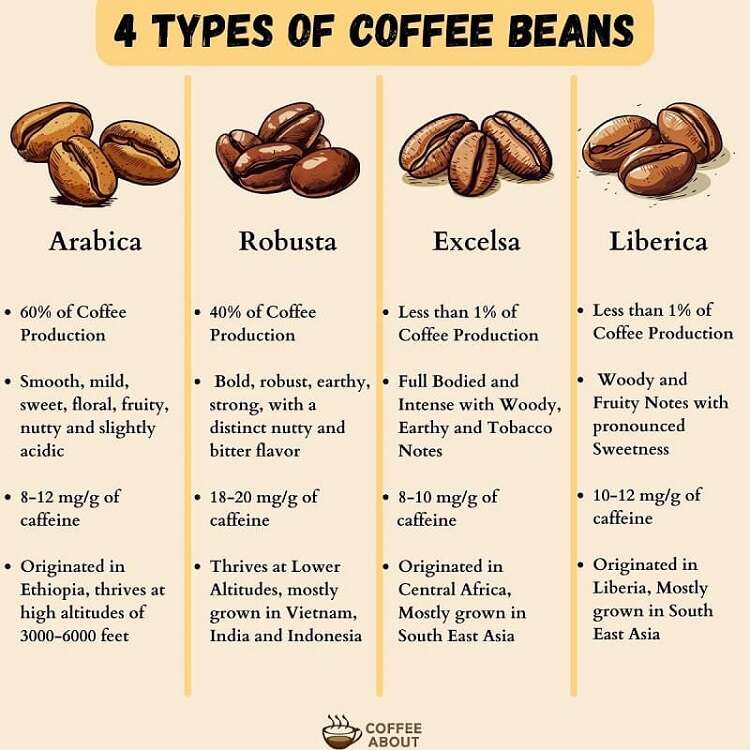
1. Arabica (Coffea Arabica)
Arabica is the most popular and widely consumed coffee species, making up about 60% of global production.
It likely originated in the mountains of Ethiopia but is now cultivated in more than 50 countries across the world, primarily in Latin and Central America, Africa, and Asia with Brazil and Colombia among the major producers.
Arabica has many varieties, such as Bourbon, Typica, and Caturra. Each variety has distinct characteristics, but all tend to produce a sweeter and more aromatic brew compared to other coffee species.
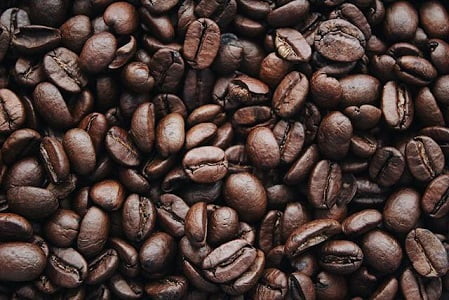
The taste and characteristics of Arabica
Arabica beans tend to be larger and oval-shaped with a signature crease down the middle.
They thrive in the cool, high-altitude climates found in mountainous subtropical regions – ideally with steady rainfall between 3000-6000 feet above sea level.
The Arabica plant has a bushy shrub-like structure that’s easy to prune and harvest, though it’s prone to major coffee diseases like leaf rust and coffee berry disease (CBD).
Arabica beans deliver the tastiest coffee known for its vibrant, multilayered flavors like fruit, florals, chocolate, and nuts. It offers a sweeter, more complex taste compared to other coffee varieties.
2. Robusta (Coffea Canephora)
Robusta refers to the Coffea canephora species of coffee plant and makes up about 40% of commercial coffee production worldwide.
Robusta is primarily grown in Vietnam, Indonesia, India, and other lower-altitude regions with warmer equatorial climates.
Robusta beans have a very high caffeine content which is almost double that of Arabica varieties.
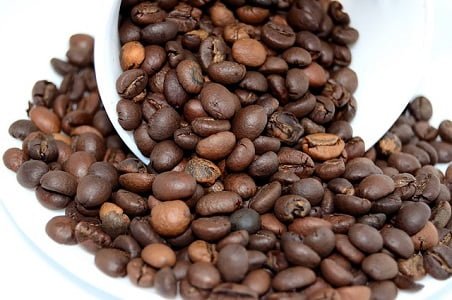
The taste and characteristics of Robusta
Robusta coffee plants are hardy little trees that can reach around 30 feet tall.
They’re really resistant to diseases and produce lots of coffee cherries, so they’re economically important and cheap.
Robusta beans deliver the strongest and full-bodied flavor profile with earthy, rubbery, and bitter undertones. It’s lower in acidity, so it doesn’t have as much sweetness as Arabica.
They’re used a lot in instant coffee and blends to add that bold taste. Robustas are also key for espresso blends since they deliver a rich flavor and frothy crema.
3. Liberica (Coffea Liberica)
Liberica coffee is a less common species originally from the African country Liberia.
Librica coffee plants are highly tolerant of tropical climates and lower altitudes, so they grow well across Southeast Asia in places like Indonesia and the Philippines.
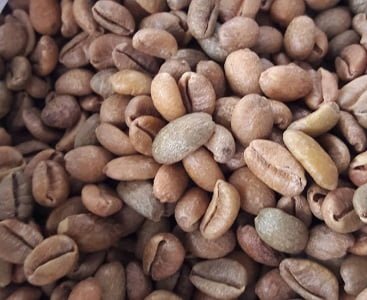
The taste and characteristics of Liberica
Liberica coffee beans have a distinctive oval shape with uneven sides and are larger than typical coffee beans.
The Liberica plant itself is impressively tall, growing up to 60 feet high like a tree, unlike other coffee species that are more shrub-like.
The taste of Liberica is described as being significantly sweeter than Arabica, with dominant fruity notes of jackfruit and berries. Despite the sweetness, Liberica has a light body and an unusual, rubbery flavor with bitter notes like Robusta.
While not as widely consumed as Arabica and Robusta, Liberica is still appreciated by some coffee lovers for its unique flavor profile.
4. Excelsa (Coffea Excelsa)
Excelsa was originally discovered in Central Africa in the early 1900s and was classified as its own species until 2005. After that, it was reclassified as a sub-variety of Coffea Liberica called Dewevrei.
Excelsa beans have the least caffeine of all coffee types. It’s usually grown in Southeast Asia and added to blends to impart its exotic tarty flavors.
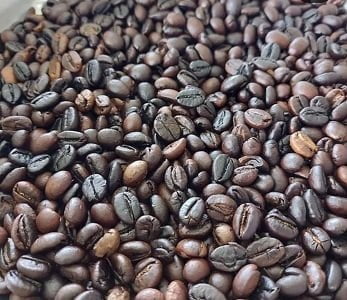
The taste and characteristics of Excelsa
The Excelsa coffee bean is much smaller and rounder compared to other species. The plants thrive at relatively low altitudes between 1,000-1,300 feet and can reach up to 50 feet tall.
Excelsa delivers a truly complex and distinctive flavor profile. It has berry-like notes and a full body with a creamy mouthfeel, along with woody and even slightly popcorn-like flavors. Excelsa is less sweet with more tartness compared to other coffees.
Different Coffee Cultivars and Varieties
| Variety | Features |
|---|---|
| Typica | The oldest and most widespread Arabica variety |
| Bourbon | Sweet, balanced, and aromatic Arabica |
| Caturra | Dwarf, high yield Arabica variety |
| Catimor | Robusta-Arabica hybrid for disease resistance |
| Villa Sarchi | Productive, fine Arabica variety from Costa Rica |
| Geisha | Famous Panamian Coffee known for its floral and tea-like taste |
| Kona | Smooth, mild Arabica from Hawaii |
| Maragogipe | Brazilian Arabica known for very large beans |
| Sagada | Heirloom Arabica from the Philippines |
| Mundo Novo | High-yielding and productive Arabica hybrid |
| Pacamara | Salvadoran Arabica famous for its fruity taste |
| Pacas | Highly Productive Arabica variety from Rwanda and Burundi |
| Java | Classic Indonesian Arabica known for heavy body |
| Sarchimor | Disease resistant and high yielding Arabica-Robusta hybrid |
| SL 28 & SL 34 | High quality Kenyan Arabica cultivars |
| Timor | Natural Arabica-Robusta hybrid from East Timor |
| Maracaturra | Dwarf mutation of the Caturra Arabica |
| Ethiopian Heirlooms | Diverse array of wild Arabica varieties |
| Catuai | High-yielding Brazilian Arabica hybrid |
How to choose the right type of coffee beans?
Here are some factors you must consider while selecting the right type of coffee beans for your home brewing journey!
Consider the Origin and type of Beans
When picking out coffee beans, start by considering the origin.
Coffee from Africa often has sweet, fruity notes. Beans from South America taste rich and chocolaty. And coffee grown in Southeast Asia tends to be intense, full-bodied, and bitter.
The type of beans is also key.
For pour-over and drip coffee, go with 100% Arabica beans to get a nice smooth, sweet flavor.
If you are an Espresso fan, an Arabica-Robusta bean blend is best – the Robusta gives a rich, thick body and frothy crema.
And if you want to try something new and unusual give Liberica and Excelsa a try.
Also Read: What country has the best coffee
The Roast Type
The degree of coffee roast is another important factor.
If you are buying single-origin always go for lighter roasts. Light roasts retain more of the bean’s original fruity, floral, or citrusy flavor notes.
Medium roasts are balanced in flavor and a popular choice for regular brewed coffee.
If you prefer milky coffee beverages Dark roasts are the perfect choice. They are roasted longer, resulting in intense, rich, sometimes bittersweet flavors that stand up well with the creaminess of the milk.
Dark roasts like Italian or French Roast are also popular for French press and Espresso.
Also Read: Light vs Dark roast
As an Amazon Associate, I earn commission from qualifying purchases.
Shop my Favorite Beans in each type
- Buy Illy Classico 100% Arabica Beans on Amazon – https://amzn.to/3UqheZt
- Buy Nguyen Coffee Supply Hanoi Peaberry Robusta Beans – https://amzn.to/40klyx7
- Excelsa Coffee Beans – https://amzn.to/48v7GSU
- Artisans Barako Gold Liberica Coffee Beans – https://amzn.to/3YmMvhd
Final Thoughts
And that wraps up our tour of all the types of coffee beans!
I hope this guide helped explain the different species, varieties, flavors, and buying tips.
Let me know in the comments if you have a favorite type of bean I should try – I’m always looking to expand my coffee horizons!
FAQs
What is the most expensive coffee bean in the world?
Panamanian Geisha, Black Ivory, and Kopi Luwak are among the most expensive coffees in the world.
These rare beans can fetch over $100-$500 per pound due to their unique flavors and limited supply!
What Country produces the most Coffee?
Brazil produces the most coffee in the World accounting for almost 25% of overall coffee production followed by Colombia, Vietnam, Indonesia, and Ethiopia.
Where are coffee beans grown?
Coffee is grown in tropical regions around the equator, mainly in Latin America, Africa, Asia, and some islands in the Pacific.
The ideal growing conditions are found between the Tropics of Cancer and Capricorn known as the “Bean Belt”.



